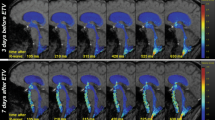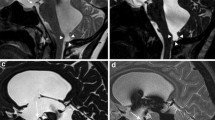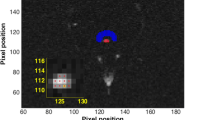Abstract
Introduction
In the current study, we aimed to compare the diagnostic efficacies of phase-contrast magnetic resonance imaging (PC-MRI) and three-dimensional constructive interference in steady-state (3D-CISS) sequence over detection of aqueductal stenosis (AS) on the basis of contrast-enhanced magnetic resonance cisternography (MRC).
Methods
Twenty-five patients with clinically and radiologically suspected AS were examined by PC-MRI, 3D-CISS, and MRC. Axial–sagittal PC-MRI and sagittal 3D-CISS were applied to view the cerebral aqueduct. Following injection of 0.5–1 ml intrathecal gadolinium diethylenetriamine pentaacetic acid (Gd-DTPA) injection, postcontrast MRC images were obtained in three planes in early and late phases. Aqueductal patency was scored as follows: grade 0, normal; grade 1, partial narrowing; and grade 2, complete obstruction. Results of PC-MRI and 3D-CISS were compared with the findings of MRC.
Results
In PC-MRI, seven cases were assessed as grade 0, 16 cases grade 1, and two cases grade 2. As a result of 3D-CISS sequence, eight cases were evaluated as grade 0, 12 cases grade 1, and five cases grade 2. Based on MRC, nine cases were assessed as grade 0, whereas nine and seven cases were evaluated to be grades 1 and 2, respectively. Five cases that demonstrated partial patency in PC-MRI or 3D-CISS showed complete obstruction by MRC.
Conclusion
PC-MRI is helpful in confirming the AS. However, positive flow does not necessarily exclude the existence of AS. 3D-CISS sequence provides excellent cerebrospinal fluid-to-aqueduct contrast, allowing detailed study of the anatomic features of the aqueduct. MRC should be performed on patients who demonstrate suspected AS findings on PC-MRI and/or 3D-CISS sequences.




Similar content being viewed by others
References
Yadav YR, Mukerji G, Parihar V, Sinha M, Pandey S (2009) Complex hydrocephalus (combination of communicating and obstructive type): an important cause of failed endoscopic third ventriculostomy. BMC Res Notes. doi:10.1186/1756-0500/2/137
Bateman GA (2007) Magnetic resonance imaging quantification of compliance and collateral flow in late-onset idiopathic aqueductal stenosis: venous pathophysiology revisited. J Neurosurg 107:951–958
Allan R, Chaseling R, Graf N, Dexter M (2005) Aqueduct stenosis—benign? J Clin Neurosci 12:178–182
Tisell M (2005) How should primary aqueductal stenosis in adults be treated?—a review. Acta Neuro Scand 111:143–153
Grossman RI, Yousem DM (2003) Neuroradiology the requisites, 2nd edn. Mosby Elsevier, Philadelphia, pp 372–373
El Sankari SS, Lehmann P, Gondry-Jouet C, Fichten A, Godefroy O, Meyer ME, Baledent O (2009) Phase-contrast MR imaging support for the diagnosis of aqueductal stenosis. AJNR Am J Neuroradiol 30:209–214
Da Silva LRF, Cavalheiro S (2007) Endoscopic aqueductoplasty in the treatment of aqueductal stenosis. Childs Nerv Syst 23:1263–1268
Atlas SW, Mark AS, Fram EK (1998) Aqueductal stenosis: evaluation with gradient-echo rapid MR imaging. Radiology 169:449–453
Fukuhara T, Luciano MG (2001) Clinical features of late-onset idiopathic aqueductal stenosis. Surg Neurol 55:132–136
Aleman J, Jokura H, Higano S, Akabane A, Shirane R, Yoshimoto T (2001) Value of constructive interference in steady-state, three-dimensional, Fourier transformation magnetic resonance imaging for the neuroendoscopic treatment of hydrocephalus and intracranial cysts. Neurosurgery 48:1291–1295
Schroeder HWS, Schweim C, Schweim KH, Gaab MR (2000) Analysis of aqueductal cerebrospinal fluid flow after endoscopic aqueductoplasty by using cine phase-contrast magnetic resonance imaging. Neurosurg Focus 9:1–8
Schroeder HWS, Oertel J, Gaab MR (2004) Endoscopic aqueductoplasty in the treatment of aqueductal stenosis. Childs Nerv Syst 20:821–827
Doll A, Christmann D, Kerhli P, Abu Eid M, Gillis C, Bogorin A, Thiebaut A, Dietemann JL (2000) Contribution of 3D-CISS MRI for the post therapeutic monitoring of obstructive hydrocephalus. J Neuroradiol 27:218–225
Joseph VB, Raghuram L, Korah IP, Chacko AG (2003) MR ventriculography for the study of CSF Flow. AJNR Am J Neuroradiol 24:373–381
Lee HS, Rao KCVG, Zimmerman RA (1999) Cranial MRI and CT, 4th edn. McGraw-Hill, New York, pp 173–241
Aydin K, Terzibasioglu E, Sencer S, Sencer A, Suoglu Y, Karasu A, Kiris T, Turantan MI (2008) Localization of cerebrospinal fluid leaks by gadolinium-enhanced magnetic resonance cisternography: a 5-year single-center experience. Neurosurgery 62:584–589
Algin O, Hakyemez B, Gokalp KE, Parlak M (2009) Phase-contrast cine MRI versus MR cisternography on the evaluation of the communication between intraventricular arachnoid cysts and neighbouring cerebrospinal fluid spaces. Neuroradiology 51:305–312
Nilsson S, Ortoft K, Mölstad S (2008) The accuracy of general practitioners' clinical assessment of chest pain patients. Eur J Gen Pract 14:50–55
Kehler U, Regelsberger J, Gliemroth J, Westphal M (2006) Outcome prediction of third ventriculostomy: a proposed hydrocephalus grading system. Minim Invasive Neurosurg 49:238–243
Kadowaki C, Hara M, Numoto M, Takeuchi K, Saito I (1995) Cine magnetic resonance imaging of aqueductal stenosis. Childs Nerv Syst 11:107–111
Drayer BP, Rosenbaum AE, Higman HB (1977) Cerebrospinal fluid imaging using serial metrizamide CT cisternography. Neuroradiology 28:7–17
Takahashi M, Arii H, Tamakawa Y (1978) Comparison of metrizamide CT cisternography with radionuclide cisternography in abnormal cerebrospinal fluid dynamics. Neuroradiology 16:199–202
Acknowledgement
We gratefully acknowledge Gokhan Ocakoglu (biostatistician), Gokhan Gokalp (radiologist), and Ender Korfalı (neurosurgeon) for their suggestions and review of the manuscript.
Conflict of interest statement
We declare that we have no conflict of interest.
Author information
Authors and Affiliations
Corresponding author
Rights and permissions
About this article
Cite this article
Algin, O., Hakyemez, B. & Parlak, M. Phase-contrast MRI and 3D-CISS versus contrast-enhanced MR cisternography on the evaluation of the aqueductal stenosis. Neuroradiology 52, 99–108 (2010). https://doi.org/10.1007/s00234-009-0592-x
Received:
Accepted:
Published:
Issue Date:
DOI: https://doi.org/10.1007/s00234-009-0592-x




